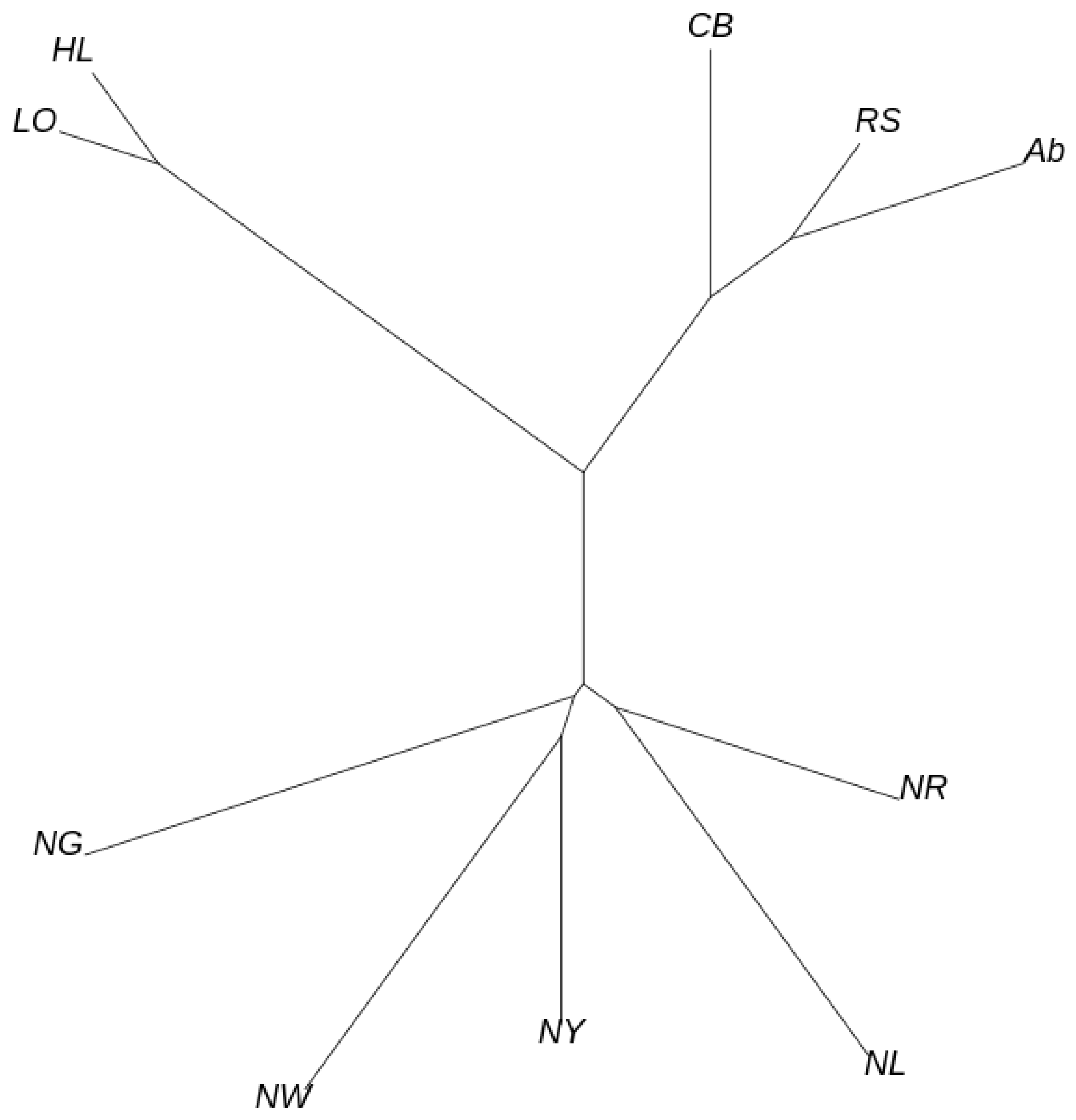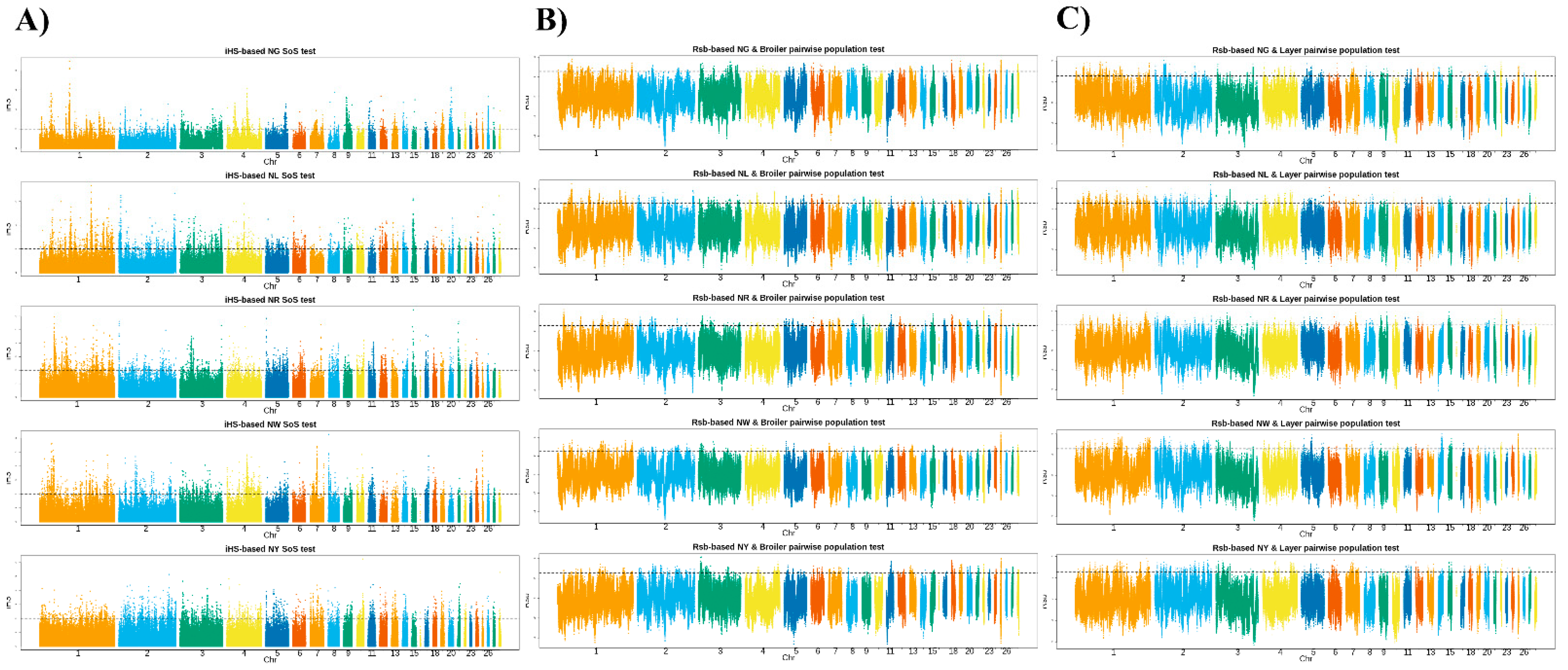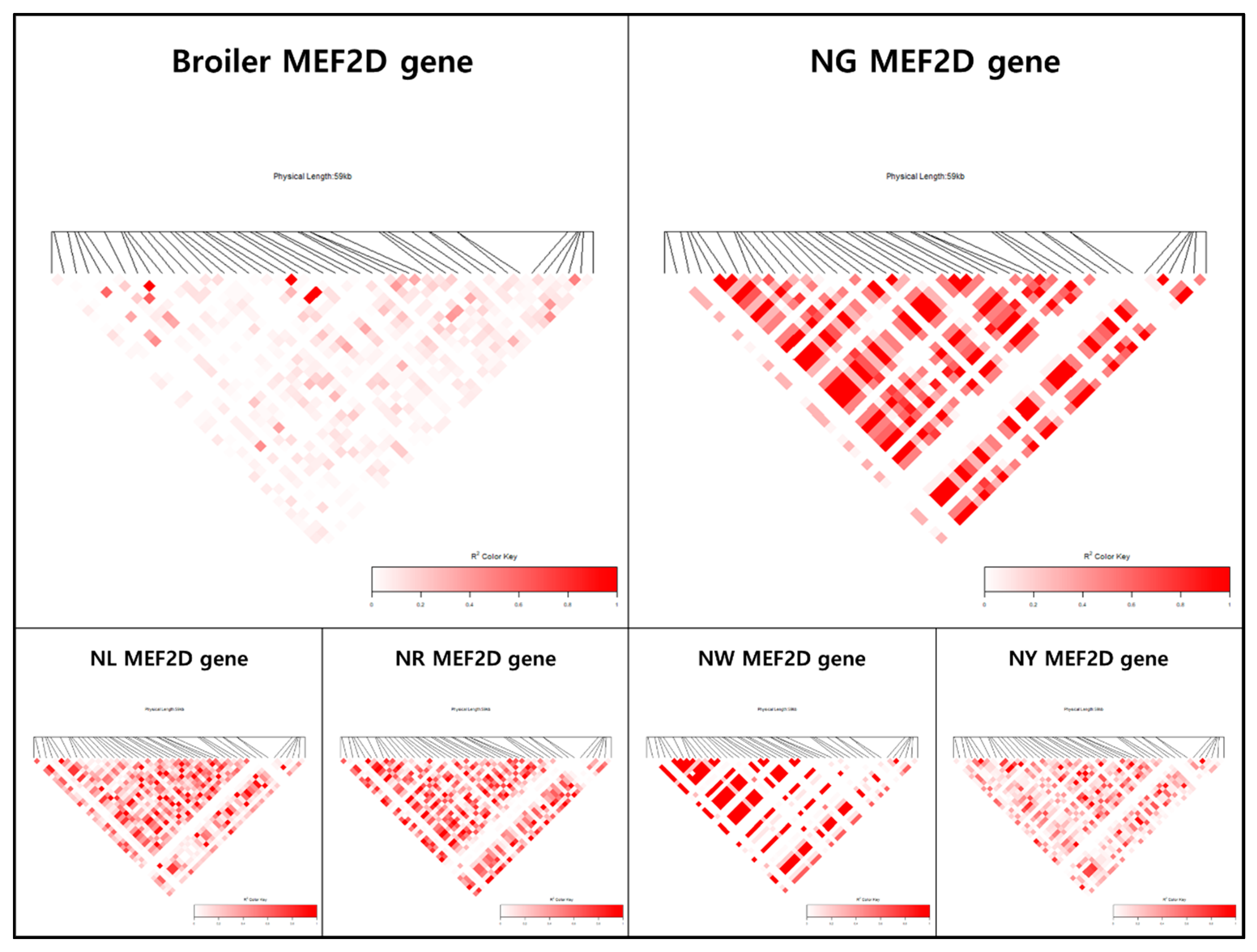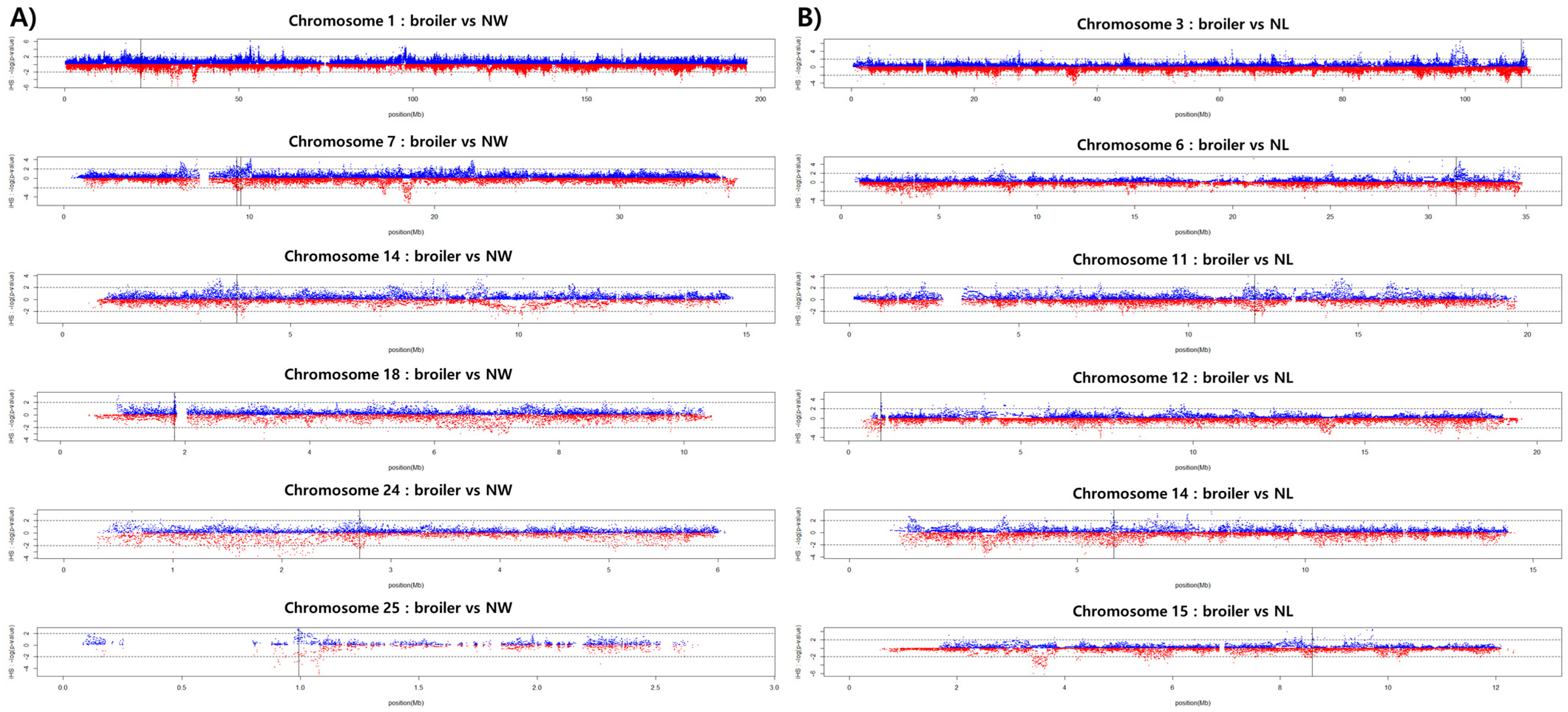Comparison of Selection Signatures between Korean Native and Commercial Chickens Using 600K SNP Array Data
Abstract
1. Introduction
2. Materials and Methods
2.1. Sample Genotyping and Genetic Diversity Analysis
2.2. LD Analysis and the Detection of Regions Exhibiting Selection Signatures Based on iHS and Rsb between Populations
- : Total number of haplotype;
- : Total number of haplotype for allele1;
- : Total number of haplotype for allele2;
- : integrated haplotype homozygosity score (nEHHS) for pop1;
- : integrated haplotype homozygosity score (nEHHS) for pop2.
2.3. Gene and Quantitative Trait Locus (QTL) Annotation
3. Results
3.1. General Diversity and Sliding Window Analyses
3.2. Detection of Selection Signatures and QTL Annotation
3.3. LD Block Profiling for Significant Selection Signal Regions
4. Discussion
5. Conclusions
Supplementary Materials
Author Contributions
Funding
Institutional Review Board Statement
Informed Consent Statement
Data Availability Statement
Acknowledgments
Conflicts of Interest
References
- Smith, J.M.; Haigh, J. The hitch-hiking effect of a favourable gene. Genet. Res. 1974, 23, 23–35. [Google Scholar] [CrossRef]
- Charlesworth, B. A hitch-hiking guide to the genome: A commentary on ‘The hitch-hiking effect of a favourable gene’by John Maynard Smith and John Haigh. Genet. Res. 2007, 89, 389–390. [Google Scholar] [CrossRef]
- Sabeti, P.C.; Varilly, P.; Fry, B.; Lohmueller, J.; Hostetter, E.; Cotsapas, C.; Xie, X.; Byrne, E.H.; McCarroll, S.A.; Gaudet, R. Genome-wide detection and characterization of positive selection in human populations. Nature 2007, 449, 913–918. [Google Scholar] [CrossRef]
- Sabeti, P.C.; Reich, D.E.; Higgins, J.M.; Levine, H.Z.; Richter, D.J.; Schaffner, S.F.; Gabriel, S.B.; Platko, J.V.; Patterson, N.J.; McDonald, G.J. Detecting recent positive selection in the human genome from haplotype structure. Nature 2002, 419, 832–837. [Google Scholar] [CrossRef]
- Browning, S.R.; Weir, B.S. Population structure with localized haplotype clusters. Genetics 2010, 185, 1337–1344. [Google Scholar] [CrossRef][Green Version]
- Zuidhof, M.; Schneider, B.; Carney, V.; Korver, D.; Robinson, F. Growth, efficiency, and yield of commercial broilers from 1957, 1978, and 2005. Poult. Sci. 2014, 93, 2970–2982. [Google Scholar] [CrossRef]
- Shin, T.K.; Wickramasuriya, S.S.; Kim, E.; Cho, H.M.; Heo, J.M.; Yi, Y.-J. Comparative study of growth performances of six different Korean native chicken crossbreeds from hatch to twelve weeks of age. Korean J. Agric. Sci. 2017, 44, 244–253. [Google Scholar]
- Lee, K.; Jung, Y.; Jung, S.; Lee, J.H.; Heo, K.N.; Jo, C. Physiochemical Characteristics of the Meat from Korean Native Chicken and Broiler Reared and Slaughtered as the Same Conditions. Korean J. Poult. Sci. 2011, 38, 225–230. [Google Scholar] [CrossRef]
- Purcell, S.; Neale, B.; Todd-Brown, K.; Thomas, L.; Ferreira, M.A.; Bender, D.; Maller, J.; Sklar, P.; De Bakker, P.I.; Daly, M.J. PLINK: A tool set for whole-genome association and population-based linkage analyses. Am. J. Hum. Genet. 2007, 81, 559–575. [Google Scholar] [CrossRef] [PubMed]
- Alexander, D.H.; Lange, K. Enhancements to the ADMIXTURE algorithm for individual ancestry estimation. BMC Bioinform. 2011, 12, 246. [Google Scholar] [CrossRef] [PubMed]
- Kamvar, Z.N.; Tabima, J.F.; Grünwald, N.J. Poppr: An R package for genetic analysis of populations with clonal, partially clonal, and/or sexual reproduction. PeerJ 2014, 2, e281. [Google Scholar] [CrossRef]
- Loh, P.-R.; Danecek, P.; Palamara, P.F.; Fuchsberger, C.; Reshef, Y.A.; Finucane, H.K.; Schoenherr, S.; Forer, L.; McCarthy, S.; Abecasis, G.R. Reference-based phasing using the Haplotype Reference Consortium panel. Nat. Genet. 2016, 48, 1443. [Google Scholar] [CrossRef]
- Gautier, M.; Vitalis, R. rehh: An R package to detect footprints of selection in genome-wide SNP data from haplotype structure. Bioinformatics 2012, 28, 1176–1177. [Google Scholar] [CrossRef] [PubMed]
- Shin, J.-H.; Blay, S.; McNeney, B.; Graham, J. LDheatmap: An R function for graphical display of pairwise linkage disequilibria between single nucleotide polymorphisms. J. Stat. Softw. 2006, 16, 1–10. [Google Scholar] [CrossRef]
- Durinck, S.; Moreau, Y.; Kasprzyk, A.; Davis, S.; De Moor, B.; Brazma, A.; Huber, W. BioMart and Bioconductor: A powerful link between biological databases and microarray data analysis. Bioinformatics 2005, 21, 3439–3440. [Google Scholar] [CrossRef] [PubMed]
- Kaynak, B.; von Heydebreck, A.; Mebus, S.; Seelow, D.; Hennig, S.; Vogel, J.; Sperling, H.-P.; Pregla, R.; Alexi-Meskishvili, V.; Hetzer, R. Genome-wide array analysis of normal and malformed human hearts. Circulation 2003, 107, 2467–2474. [Google Scholar] [CrossRef] [PubMed]
- Lange, M.; Kaynak, B.; Forster, U.B.; Tönjes, M.; Fischer, J.J.; Grimm, C.; Schlesinger, J.; Just, S.; Dunkel, I.; Krueger, T. Regulation of muscle development by DPF3, a novel histone acetylation and methylation reader of the BAF chromatin remodeling complex. Genes Dev. 2008, 22, 2370–2384. [Google Scholar] [CrossRef] [PubMed]
- Dasgupta, T.; Ladd, A.N. The importance of CELF control: Molecular and biological roles of the CUG-BP, Elav-like family of RNA-binding proteins. Wiley Interdiscip. Rev. RNA 2012, 3, 104–121. [Google Scholar] [CrossRef]
- Ladd, A.N.; Stenberg, M.G.; Swanson, M.S.; Cooper, T.A. Dynamic balance between activation and repression regulates pre-mRNA alternative splicing during heart development. Dev. Dyn. 2005, 233, 783–793. [Google Scholar] [CrossRef]
- Blech-Hermoni, Y.; Stillwagon, S.J.; Ladd, A.N. Diversity and conservation of CELF1 and CELF2 RNA and protein expression patterns during embryonic development. Dev. Dyn. 2013, 242, 767–777. [Google Scholar] [CrossRef]
- Brimacombe, K.R.; Ladd, A.N. Cloning and embryonic expression patterns of the chicken CELF family. Dev. Dyn. 2007, 236, 2216–2224. [Google Scholar] [CrossRef]
- Du, M.; Perry, R.L.; Nowacki, N.B.; Gordon, J.W.; Salma, J.; Zhao, J.; Aziz, A.; Chan, J.; Siu, K.M.; McDermott, J.C. Protein kinase A represses skeletal myogenesis by targeting myocyte enhancer factor 2D. Mol. Cell. Biol. 2008, 28, 2952–2970. [Google Scholar] [CrossRef]
- Nebbioso, A.; Manzo, F.; Miceli, M.; Conte, M.; Manente, L.; Baldi, A.; De Luca, A.; Rotili, D.; Valente, S.; Mai, A. Selective class II HDAC inhibitors impair myogenesis by modulating the stability and activity of HDAC–MEF2 complexes. EMBO Rep. 2009, 10, 776–782. [Google Scholar] [CrossRef] [PubMed]
- Della Gaspera, B.; Armand, A.-S.; Lecolle, S.; Charbonnier, F.; Chanoine, C. Mef2d acts upstream of muscle identity genes and couples lateral myogenesis to dermomyotome formation in Xenopus laevis. PLoS ONE 2012, 7, e52359. [Google Scholar] [CrossRef] [PubMed][Green Version]
- Ouyang, H.; Yu, J.; Chen, X.; Wang, Z.; Nie, Q. A novel transcript of MEF2D promotes myoblast differentiation and its variations associated with growth traits in chicken. PeerJ 2020, 8, e8351. [Google Scholar] [CrossRef] [PubMed]
- Hooper, C.L.; Paudyal, A.; Dash, P.R.; Boateng, S.Y. Modulation of stretch-induced myocyte remodeling and gene expression by nitric oxide: A novel role for lipoma preferred partner in myofibrillogenesis. Am. J. Physiol. Heart Circ. Physiol. 2013, 304, H1302–H1313. [Google Scholar] [CrossRef] [PubMed]
- Feng, Y.; Ma, C.; Zhang, Y.; Yang, X.; Zhang, D.; Xie, M.; Li, W.; Wei, J. 3′ UTR SNPs in the LPP gene associated with Immunoglobulin A nephropathy risk in the Chinese Han population. Int. Immunopharmacol. 2019, 74, 105668. [Google Scholar] [CrossRef]
- Liu, L.; Yan, Y.; Liu, L.; Xue, N.; Dong, Y.; Yang, N.; Li, X. Loci associated with the chicken resistance to Salmonella enteritidis infection revealed by genome-wide association study. J. Vet. Med. Anim. Sci. 2020, 3, 1018. [Google Scholar]
- Suzu, S.; Hayashi, Y.; Harumi, T.; Nomaguchi, K.; Yamada, M.; Hayasawa, H.; Motoyoshi, K. Molecular cloning of a novel immunoglobulin superfamily gene preferentially expressed by brain and testis. Biochem. Biophys. Res. Commun. 2002, 296, 1215–1221. [Google Scholar] [CrossRef]
- Zhang, W.; Xu, J.; Li, H.; Zhou, L.; Nie, Q.; Zhang, X.; Luo, Q. The Low Expression of DUSP1 and HSPA5 Inhibits Chicken Immune Response and Causes Decreased Immunity under Heat Stress. Res. Sq. 2019. preprints. [Google Scholar]
- Xue, M.; Zhao, Y.; Hu, S.; Shi, X.; Cui, H.; Wang, Y. Analysis of the spleen proteome of chickens infected with reticuloendotheliosis virus. Arch. Virol. 2017, 162, 1187–1199. [Google Scholar] [CrossRef] [PubMed]
- Thanthrige-Don, N.; Abdul-Careem, M.F.; Shack, L.A.; Burgess, S.C.; Sharif, S. Analyses of the spleen proteome of chickens infected with Marek’s disease virus. Virology 2009, 390, 356–367. [Google Scholar] [CrossRef] [PubMed]
- Manjula, P.; Bed’Hom, B.; Hoque, M.R.; Cho, S.; Seo, D.; Chazara, O.; Lee, S.H.; Lee, J.H. Genetic diversity of MHC-B in 12 chicken populations in Korea revealed by single-nucleotide polymorphisms. Immunogenetics 2020, 72, 367–379. [Google Scholar] [CrossRef]
- Manjula, P.; Fulton, J.E.; Seo, D.; Lee, J.H. Major histocompatibility complex B variability in Korean native chicken breeds. Poult. Sci. 2020, 99, 4704–4713. [Google Scholar] [CrossRef]
- Mignon-Grasteau, S.; Boissy, A.; Bouix, J.; Faure, J.-M.; Fisher, A.D.; Hinch, G.N.; Jensen, P.; Le Neindre, P.; Mormede, P.; Prunet, P. Genetics of adaptation and domestication in livestock. Livest. Prod. Sci. 2005, 93, 3–14. [Google Scholar] [CrossRef]
- Jensen, P. Domestication—From behaviour to genes and back again. Appl. Anim. Behav. Sci. 2006, 97, 3–15. [Google Scholar] [CrossRef]
- Chen, Y.; Lan, Y.; Zhang, S.; Li, W.; Luo, Z.; Lin, S.; Zhuang, J.; Li, X.; Li, S.; Yang, J. ErbB4 signaling in the prelimbic cortex regulates fear expression. Transl. Psychiatry 2017, 7, e1168. [Google Scholar] [CrossRef]
- Fallahsharoudi, A.; de Kock, N.; Johnsson, M.; Bektic, L.; Ubhayasekera, S.K.A.; Bergquist, J.; Wright, D.; Jensen, P. QTL mapping of stress related gene expression in a cross between domesticated chickens and ancestral red junglefowl. Mol. Cell. Endocrinol. 2017, 446, 52–58. [Google Scholar] [CrossRef]
- Johnsson, M.; Williams, M.J.; Jensen, P.; Wright, D. Genetical genomics of behavior: A novel chicken genomic model for anxiety behavior. Genetics 2016, 202, 327–340. [Google Scholar] [CrossRef] [PubMed]
- Krizsan-Agbas, D.; Pedchenko, T.; Smith, P.G. Neurotrimin is an estrogen-regulated determinant of peripheral sympathetic innervation. J. Neurosci. Res. 2008, 86, 3086–3095. [Google Scholar] [CrossRef]
- Song, G.; Seo, H.W.; Choi, J.W.; Rengaraj, D.; Kim, T.M.; Lee, B.R.; Kim, Y.M.; Yun, T.W.; Jeong, J.-W.; Han, J.Y. Discovery of candidate genes and pathways regulating oviduct development in chickens. Biol. Reprod. 2011, 85, 306–314. [Google Scholar] [CrossRef]
- Liu, Z.; Yang, N.; Yan, Y.; Li, G.; Liu, A.; Wu, G.; Sun, C. Genome-wide association analysis of egg production performance in chickens across the whole laying period. BMC Genet. 2019, 20, 67. [Google Scholar] [CrossRef] [PubMed]
- Berglund, E.O.; Ranscht, B. Molecular cloning and in situ localization of the human contactin gene (CNTN1) on chromosome 12q11-q12. Genomics 1994, 21, 571–582. [Google Scholar] [CrossRef] [PubMed]
- Yin, Z.; Lian, L.; Zhu, F.; Zhang, Z.H.; Hincke, M.; Yang, N.; Hou, Z.C. The transcriptome landscapes of ovary and three oviduct segments during chicken (Gallus gallus) egg formation. Genomics 2020, 112, 243–251. [Google Scholar] [CrossRef] [PubMed]
- Chen, L.-R.; Chao, C.-H.; Chen, C.-F.; Lee, Y.-P.; Chen, Y.-L.; Shiue, Y.-L. Expression of 25 high egg production related transcripts that identified from hypothalamus and pituitary gland in red-feather Taiwan country chickens. Anim. Reprod. Sci. 2007, 100, 172–185. [Google Scholar] [CrossRef] [PubMed]
- Kleczkowska, P.; Lipkowski, A.W. Neurotensin and neurotensin receptors: Characteristic, structure–activity relationship and pain modulation—A review. Eur. J. Pharmacol. 2013, 716, 54–60. [Google Scholar] [CrossRef] [PubMed]
- Richards, M. Genetic regulation of feed intake and energy balance in poultry. Poult. Sci. 2003, 82, 907–916. [Google Scholar] [CrossRef]
- Zhang, T.; Chen, L.; Han, K.; Zhang, X.; Zhang, G.; Dai, G.; Wang, J.; Xie, K. Transcriptome analysis of ovary in relatively greater and lesser egg producing Jinghai Yellow Chicken. Anim. Reprod. Sci. 2019, 208, 106114. [Google Scholar] [CrossRef]
- Schmidinger, B.; Weijler, A.M.; Schneider, W.J.; Hermann, M. Hepatosteatosis and estrogen increase apolipoprotein O production in the chicken. Biochimie 2016, 127, 37–43. [Google Scholar] [CrossRef]
- O’sullivan, N.; Dunnington, E.; Siegel, P. Correlated Responses in Lines of Chickens Divergently Selected for Fifty-Six–Day Body Weight.: 1. Growth, Feed Intake, and Feed Utilization. Poult. Sci. 1992, 71, 590–597. [Google Scholar] [CrossRef]






| Comparison of Population | Candidate Gene (Excluded Unknown Gene) | Genes in High LD Region | QTL Name in High LD Region | |
|---|---|---|---|---|
| Layer | NG | ADGRL2/AHR/BANP/CACYBP/CADPS2/CD200/CHTOP/CNOT2/DOT1L/DPF3/DYNC1I1/ELF1/EPHA4/FBXW11/GRM8/HDAC9/HGFAC/HPCAL1/KCTD1/LOC112532947/MOB2/MYO18B/NARS2/OTUD7B/PAWR/PDE3A/PDLIM4/PDZRN3/PEBP1/PHF14/PLXNB2/POLA1/PPHLN1/RCOR1/RHOV/RNF216/RUNX1/SDHAF3/SLC15A4/SLC4A5/SNX13/TAOK3/UMAD1/UPK1B/USP15/WNT3A/YAP1 | UPK1B/IGSF11/DPF3/PPHLN1/PPHLN1/PRICKLE1 | Breast muscle pH |
| NL | AEBP2/ANAPC4/B3GAT1L/CAMK2G/CHAT/CNOT2/DDX10/DIAPH3/DSCAM/ELF1/GALNT7/GALNTL6/KCTD1/LSAMP/MAP4K4/MYBPC1/PDE3A/PDK3/PHF14/PLXNB2/POLA1/PTK2/QTRT2/RAP1B/RAPGEF5/SEPSECS/SLC36A4/SNX13/SRRM1/STIM2/TBC1D19/TDRD3/TMEM245/UPK1B/USP15/VWA8/WASL/WNT3A/ZMIZ1 | - | - | |
| NR | A4GNT/AGR2/ANKMY2/ANKRD28/BARX1/C1QTNF4/CELF1/CLASP1/CNTN5/CYP24A1/DIRC2/EP400/GALNTL6/GPR83/GRM8/IL1RAPL1/KAT2B/MAP4K4/MEOX2/MSRA/PAXIP1/PLXNB2/RAPGEF5/RPAP1/RYK/SDHAF3/SNX13/SPON1/STIM2/STK25/SYT10/TBC1D5/TOP2B/TSPAN7/USP25/WNT7A | - | - | |
| NW | ADCY9/AIFM3/ASB4/C22H2ORF42/CHN1/DDIAS/DPF3/DYNC1I1/EED/ELF1/EXT1/FSHR/GEMIN8/GPR158/HYAL6/IL1RAPL1/INO80/KIAA1217/LOC101751443/MCM5/ME3/MIPEP/MIR6672/NARS2/NOX4/OTUD7B/PDK3/POLA1/PRCP/RBFOX1/RGS6/SAT1/SDHAF3/SIPA1L1/SOSTDC1/STK3/SV2B/SYT1/TOP2B/TSPAN33/TSPAN7/TYRO3/UBE3B/UMAD1/USP15/VRK2/WDYHV1/YAP1/ZHX1/ZHX2 | SIPA1L1/SV2B/SDHAF3/NOX4 | Fear—tonic immobility duration, breast muscle pH, feather-crested head, pH of digestive tract contents, tibia length, dry matter intake, feed intake, albumen height | |
| NY | A1CF/AIFM3/AMBRA1/ANKRD33B/APPBP2/BRIP1/C22H2ORF42/CAMK2G/CERS6/CHN1/CREB3L1/CRIM1/DNAJC5/FBXW11/GALNTL6/GPR78/HTRA3/IGF2BP3/IL1RAPL1/KCTD1/KLHL41/LHX1/LRP2/LYPLAL1/MCM5/NEK6/PDE3A/PRPF6/RHOV/RNASEH2B/SERPINE3/SLC15A4/STIM2/STK3/TMEM132B/TTC3/VRK2/WASL/WDYHV1/ZFX/ZHX2 | - | - | |
| Broiler | NG | ACSBG2/AGRN/BMT2/CABIN1/CASTOR2/CNOT2/CNTN1/COMMD1/CUX1/DTNA/FARP2/FBXO42/GNA11/GPR132/HIF1A/INTS4/KCNC2/LOC112533299/MAP3K20/MIR6680/MOB1A/MOB2/MXD1/MYH10/NTSR1/OGFR/OTUD7B/P2RY8/PIAS4/PTPRF/PTPRT/PTTG1IP/RHOB/S100A6/SLCO4A1/TACR1/ZAP70/ZNF277 | CNTN1/NTSR1/MEF2D | Breast muscle pH, feed conversion ratio, comb weight, wattles weight, ileum weight |
| NL | ADIPOQ/ANAPC10/AUTS2/CDK8/CELF1/CNOT2/EFL1/GAB1/GAP43/GRID1/IGSF11/IL6/KCNC2/LMNB2/LOC112533299/LSAMP/MARCH2/MPRIP/MTFR1L/MYH10/PROM1/PTK2/PTP4A3/PTTG1IP/RUNX3/S1PR4/SLC10A7/SLC38A1/SNCG/SPON1/TDRD3/TTC32 | MEF2D/LMNB2/LONP1/SLC1A6/RANBP3/KLHL33/NDUFA11/BTN1A1 | Feed conversion ratio, cecal bacterial burden after challenge with Salmonella T, ileum weight, comb weight, wattles weight | |
| NR | A4GNT/ADD2/ALG10/ALKBH8/BICD1/C23H1ORF94/CABIN1/CELF1/CELSR1/CHMP4B/CPNE8/DMD/DVL1/FARP2/HDGFL1/IGSF3/IKZF2/LOC396098/LOC419409/MIR6680/MYH10/PTPRN2/PTTG1IP/RARB/SEMA5B/SINHCAF/SPDYA/TBC1D22A/TMTC1/TNRC6C/TOP1/TSPAN7 | HDGFL1/RRNAD1/CRABP2/LOC425431/BCAN/HAPLN2/RHBG/MEF2D | Feed conversion ratio, cecal bacterial burden after challenge with Salmonella T, ileum weight, comb weight, wattles weight | |
| NW | CABIN1/CHD2/CNOT2/DMD/EIF2S3/ERBB4/GABRB2/HNRNPDL/INTS4/JMJD1C/KCNC2/LOC101751443/LOC112533299/MIR6672/MYO7A/NTM/OFD1/OTUD7B/PAK1/PDK3/POLA1/PRKCD/SLC38A1/SPON1/ZAP70 | EIF2S3/APOO/MEF2D/POLA1/ERBB4/GABRB2/NTM/MIR1601 | Egg number, ovary weight, age at first egg, fear—tonic immobility duration, feed conversion ratio, feather pecking, testes weight | |
| NY | CDC42BPA/CEBPG/CHMP4B/COX10/DSCAM/EPHB2/FAM18B1/FGFRL1/IKBKE/JMJD1C/KCNJ9/KIF16B/MRGBP/MYH10/PROM1/PURG/RAB18L/RIC3/SNRPB2/SSH2/STX8/ULK2 | MEF2D | Feed conversion ratio, ileum weight, comb weight, wattles weight | |
| Comparison of Population | Chromosome | Candidate Gene | QTL Name in Shared Selective Sweep Region | |
|---|---|---|---|---|
| Layer | NG | 8, 9, 19 | ACSL3/DTX2/ENSGALG00000045942/ENSGALG00000037501/SSC4D/ENSGALG00000017358/ENSGALG00000001926/SRRM3/MDH2/TMEM120A/ENSGALG00000002053/TAF15 | Feathered feet, wattles weight, fecal egg count, feed intake, feather pecking, alternative complement activation by BRBC, feed conversion ratio |
| NL | 3, 6, 11, 12, 14, 15 | CUZD1/C10orf88/SFMBT1/LMF1/ENSGALG00000006648 | Abdominal fat percentage, breast muscle weight, age at sexual maturity, ovary weight, ovary percentage, breast muscle pH, feed intake, dry matter intake, jejunum weight, feathered feet, wattles length, body weight (36 days), body weight, ileum length, body temperature | |
| NR | 8, 11, 18 | ENSGALG00000005377 | Feathered feet, breast muscle pH, dry matter intake, jejunum weight, feed intake, body weight (hatch) | |
| NW | - | - | - | |
| NY | 2, 11, 14, 21, 22, 28 | ADGRB1/ENSGALG00000032326/LMF1/KIF1B/ENSGALG00000002797/ENSGALG00000024481/DFFA/PEX14/DOT1L | Wattles weight, breast muscle pH, feed intake, dry matter intake, jejunum weight, wattles length, body weight (36 days), body weight, gizzard weight, antibody titer to SRBC antigen, abdominal fat weight, breast muscle percentage, feather-crested head, gizzard percentage, eggshell color, small yellow follicle number, ovary weight, body weight (hatch) | |
| Broiler | NG | 7, 14, 24, 25 | SESTD1/ENSGALG00000004398 | Ovary weight, comb weight, body temperature, wattles length, breast muscle pH, fear—tonic immobility duration, feed conversion ratio, wattles weight |
| NL | - | - | - | |
| NR | 5 | RASGRP1/FAM98B | - | |
| NW | 1, 7, 14, 18, 24, 25 | ENSGALG00000001183/ENSGALG00000028706/ENSGALG00000024141/ENSGALG00000039987/ENSGALG00000028843/ENSGALG00000040425/ENSGALG00000045923/ENSGALG00000045397/ENSGALG00000037114/ENSGALG00000030308 | Breast muscle pH, ovary weight, comb weight, body weight (56 days), shank length, body temperature, wattles length, ileum weight, fear—tonic immobility duration, feed conversion ratio, wattles weight | |
| NY | 7, 10, 14, 27 | ENSGALG00000033329/ENSGALG00000007687/ENSGALG00000004398/WNT9B/ENSGALG00000001079/ENSGALG00000001055 | Ovary weight, comb weight, body temperature, wattles length, wattles weight, pH of digestive tract contents, egg production rate | |
Publisher’s Note: MDPI stays neutral with regard to jurisdictional claims in published maps and institutional affiliations. |
© 2021 by the authors. Licensee MDPI, Basel, Switzerland. This article is an open access article distributed under the terms and conditions of the Creative Commons Attribution (CC BY) license (https://creativecommons.org/licenses/by/4.0/).
Share and Cite
Cho, S.; Manjula, P.; Kim, M.; Cho, E.; Lee, D.; Lee, S.H.; Lee, J.H.; Seo, D. Comparison of Selection Signatures between Korean Native and Commercial Chickens Using 600K SNP Array Data. Genes 2021, 12, 824. https://doi.org/10.3390/genes12060824
Cho S, Manjula P, Kim M, Cho E, Lee D, Lee SH, Lee JH, Seo D. Comparison of Selection Signatures between Korean Native and Commercial Chickens Using 600K SNP Array Data. Genes. 2021; 12(6):824. https://doi.org/10.3390/genes12060824
Chicago/Turabian StyleCho, Sunghyun, Prabuddha Manjula, Minjun Kim, Eunjin Cho, Dooho Lee, Seung Hwan Lee, Jun Heon Lee, and Dongwon Seo. 2021. "Comparison of Selection Signatures between Korean Native and Commercial Chickens Using 600K SNP Array Data" Genes 12, no. 6: 824. https://doi.org/10.3390/genes12060824
APA StyleCho, S., Manjula, P., Kim, M., Cho, E., Lee, D., Lee, S. H., Lee, J. H., & Seo, D. (2021). Comparison of Selection Signatures between Korean Native and Commercial Chickens Using 600K SNP Array Data. Genes, 12(6), 824. https://doi.org/10.3390/genes12060824







